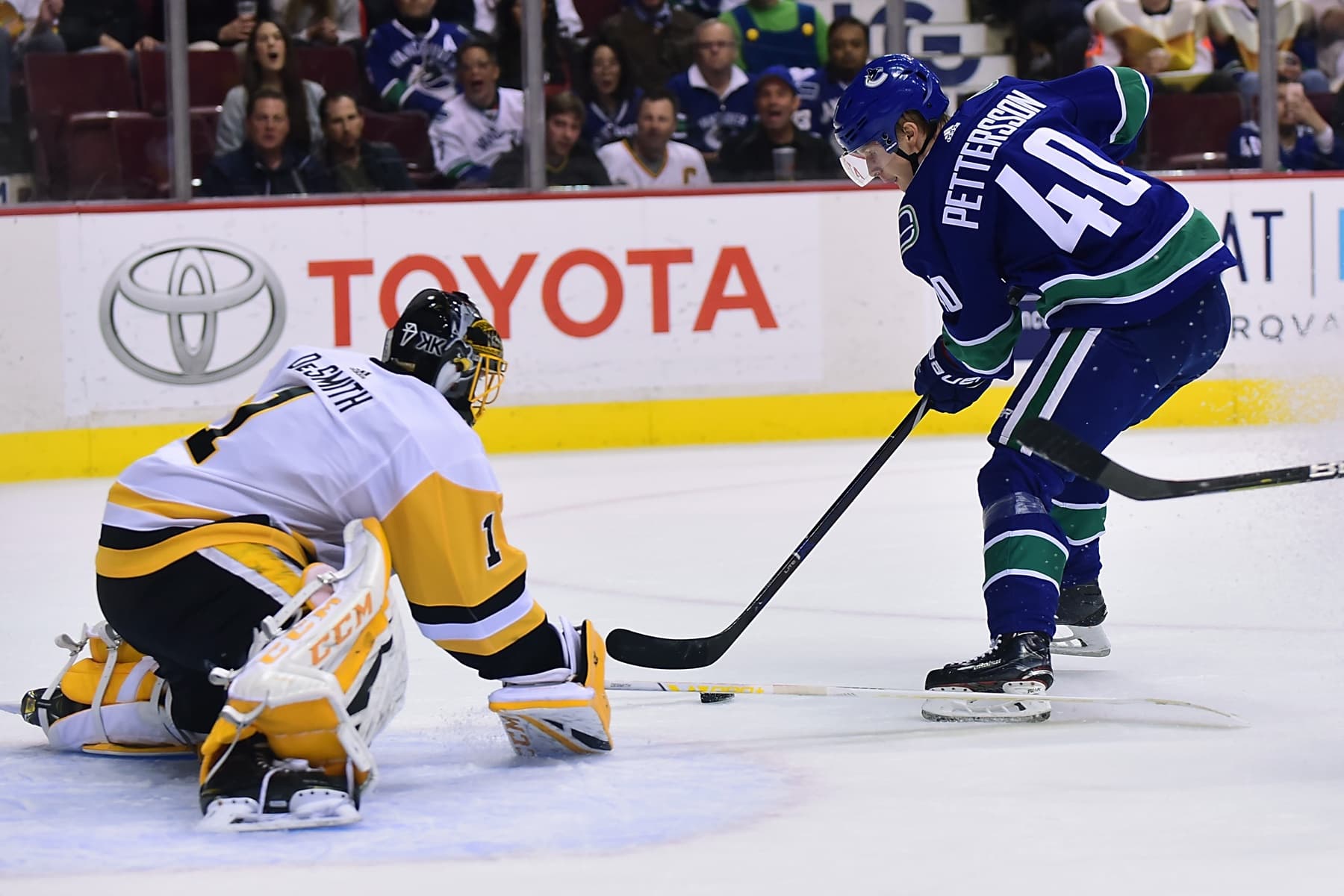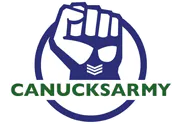Nation Sites
The Nation Network
CanucksArmy has no direct affiliation to the Vancouver Canucks, Canucks Sports & Entertainment, NHL, or NHLPA
Why the Canucks are good-to-go cap-wise following the Pearson/DeSmith trade

Photo credit: © Anne-Marie Sorvin-USA TODAY Sports
Sep 20, 2023, 11:05 EDTUpdated: Sep 20, 2023, 11:06 EDT
Consider it done.
All summer long, we reported that the Vancouver Canucks would have issues getting under the salary cap heading into the 2023/24 season, but that those issues were minor in nature and should be easily solved.
And, in one fell swoop, they essentially have been.
On Tuesday, Tanner Pearson (and his one year, $3.25 million AAV contract) was traded to the Montreal Canadiens along with a 2025 third round pick in exchange for Casey DeSmith (and his one year, $1.8 million AAV contract).
We had estimated that the Canucks needed to gain about $1.25 million in extra cap space in order to ice a reasonably-sized roster for opening night after placing Tucker Poolman on LTIR. With this move, they’ve gained $1.45 million, which is definitely enough.
Here’s why.
Under the cap? Not quite
First and foremost, we should clarify some terms.
When we say that the Canucks are out of the cap danger zone, we don’t mean that the Canucks are going to be able to get under the NHL’s $83.5 million cap ceiling for 2023/24.
Such a feat is possible now, but it’s just not practical. To truly be under the cap, the Canucks would have to put together a roster that stayed under that ceiling including Poolman’s $2.5 million cap hit.
The Canucks could pull that off, but only by running a roster of 20, meaning zero extra players. That’s not really an option for most NHL teams, and definitely not for the one that travels the most.
All this means is that the Canucks will need to rely on Poolman’s LTIR relief space to get cap-compliant, and all that means is that the Canucks will once again not be able to accrue cap space as the season goes along.
The cap-compliant part is actually pretty easy now.
The $86 million challenge
Alright, hopefully you remember this little game from last year, when the Canucks played it perfectly.
If the Canucks are going to place Poolman on LTIR and use the relief space that comes with it, what they want to do now is maximize that relief space. In short, the amount of relief space you get is the amount that your LTIRed player puts you over the cap, up to a max of that player’s full cap hit.
In layperson’s terms, that means that we’re operating under Price is Right rules here. The Canucks want to put together a roster that goes as close to the total of cap ceiling plus Poolman’s cap hit ($83.5 million + $2.5 million= $86 million) without going over.
So, the magic number is $86 million, or as near to it as AGM Emile Castonguay and Co. can muster.
Putting together a cap-maximizing roster
Now, the Canucks have options. We’ll first look at their likely opening night roster, and then see if we can’t tweak it a little to maximize that relief space.
Forward:
Kuzmenko ($5.5 mil) | Pettersson ($7.35 mil) | Boeser ($6.65 mil) |
Beauvillier ($4.15 mil) | Miller ($8 mil) | Mikheyev ($4.75 mil) |
Höglander ($1.1 mil) | Suter ($1.6 mil) | Garland ($4.95 mil) |
Joshua ($825K) | Blueger ($1.9 mil) | Podkolzin ($925K) |
Di Giuseppe ($775K) |
Forward total: $48.475 million for 13 forwards.
(Don’t pay too much attention to the lines, we didn’t put that much thought into them.)
Defence:
Hughes ($7.85 mil) | Cole ($3 mil) |
Soucy ($3.25 mil) | Hronek ($4.4 mil) |
Irwin ($775K) | Myers ($6 mil) |
Wolanin ($775K) | Juulsen ($775K) |
Defence total: $26.825 million for eight defenders.
(Again, don’t pay too much attention to the pairings.)
Goaltending:
Demko ($5 mil) |
DeSmith ($1.8 mil) |
Goaltending total: $6.8 million for two goaltenders.
And let’s not forget about the non-roster expenditures!
Non-roster:
Andrei Kuzmenko ($850K) | Bonus overages |
Oliver Ekman-Larsson ($147K) | Buyout penalty |
Tucker Poolman ($2.5 mil) | To be placed on LTIR |
Non-roster total: $3.497 million for nothin’.
So, where does that leave the Canucks?
Combine all those totals, and you’re left with a team cap hit of $85.597 million.
That is below the Canucks’ $86 million adjusted functional cap, but it’s not quite as close as we would like. That would lock the Canucks in at a max cap expenditure of $85.597 million, but if they can get it closer to $86 million as they set their opening night roster, it’s basically up to $403K in free cap space.
Chasing $86 million
This year, it won’t be quite so simple as “papering” player down on opening day.
The only player on this roster that does not require waivers to be sent down is Vasily Podkolzin, and he carries with him a bonus-laden contract. If he were to be sent down and then recalled later, the Canucks would have to carve out enough room for his $925K base cap hit and his maximum $850K in bonuses. That amount could go into the so-called “Bonus Cushion” space, but that’s probably an unnecessary complication.
It should be far simpler to pick out two low-salaried players that the Canucks are comfortable waiving, and temporarily replacing them on the opening night roster with someone making slightly more.
For example, if the Canucks waived both Christian Wolanin and Noah Juulsen (both at $775K) before opening day and replaced them on the roster with Cole McWard ($923K) and Nikita Tolopilo ($950K), they’d add an extra $323K to their cap hit. That’d put them at an opening night cap hit of $85.9 million, which might be as close as they can get this year.
Then, before the first game, McWard and Tolopilo go down, Wolanin and Juulsen come back up, and the season begins. That extra little $323K cushion stays on the books, too.
The Ilya Mikheyev question
The only further complication we can foresee at this point is the possibility of Ilya Mikheyev not being quite ready to go to start the year.
But this is only barely a complication.
All that would really require is the Canucks running a 22-player roster until Mikheyev returns, as that $323K extra space would not be enough to accommodate another replacement. Alternatively, the team could use retroactive LTIR to gain some more temporary relief, use that to call up a Mikheyev replacement, and then send that player back down before Mikheyev is activated.
Easy peasy.
There is, of course, more that feasibly could happen to complicate the situation between now and October 11. Further injuries could occur, players could disappoint to the point of needing demotion, tempting options might come across the waiver wire, and etcetera.
The main point still stands that, with the Pearson trade, the Canucks have given themselves exactly as much cap flexibility as they needed to have some roster-setting options, instead of being painted into a cap-mandated corner for the umpteenth season in a row.
Things might not be all the way fixed, but they are undoubtedly getting better.
Breaking News
- The Statsies: A big game from Aatu Räty helps Canucks overcome Wild
- Wagner’s Weekly: Is Canucks’ Jim Rutherford pulling off a stealth tank?
- Canucks assign Jonathan Lekkerimäki to AHL Abbotsford
- The Stanchies: Youth carries Canucks in weekend win vs. Wild
- Instant Reaction: Räty scores a pair, Willander pots first NHL goal in Canucks’ 4-2 win over Wild

